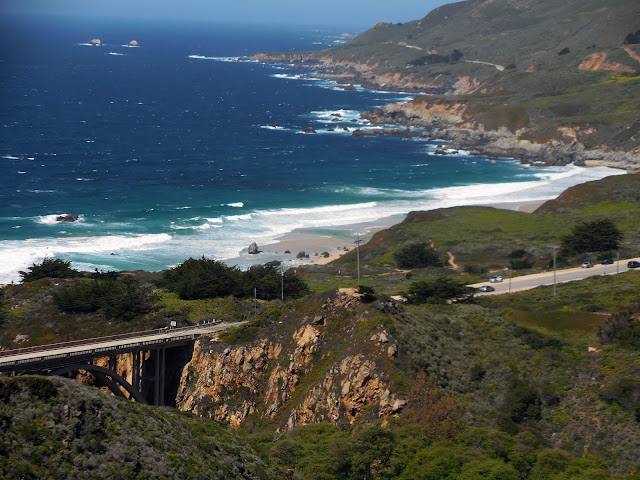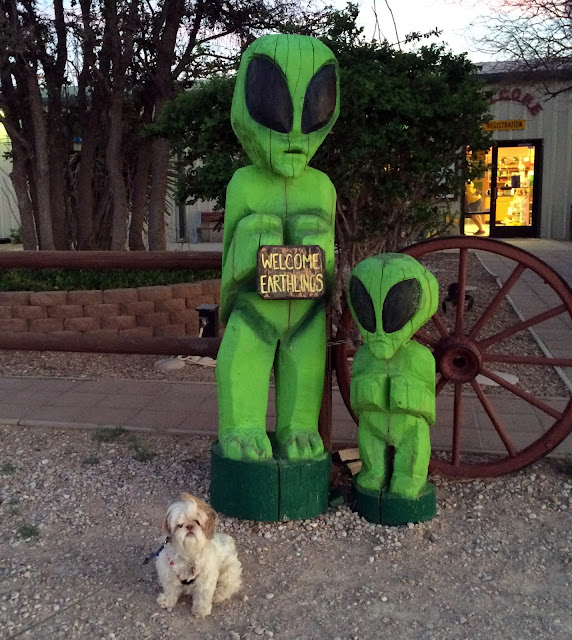The only thing that could possibly tear us away from Sedona was the lure of the California Coast. With wise forethought, Doug planned our next stop to teach a workshop in Monterey. As an added incentive, one of Doug's artist friends graciously offered for us to stay in a studio apartment on her ocean front property in Garrapata. As much as we love trailer life, we readily jumped ship and left the trailer in storage at a half-way point of our 700 mile journey, giving our reliable Honda Ridgeline a much needed rest.
Once we were through the barren desert and the Los Angeles basin, we were in awe of the vast agricultural areas, reminding us how we all owe a debt of gratitude to California farmers. We passed field after field of vegetables such as broccoli, kale and cabbage, as well as groves of orange and lemon trees. One of the students in Doug's workshop has a husband who recently retired from a career in the agriculture industry. We learned from him that due to the temperate climate in Monterey, strawberries can be harvested for eleven months of the year. This explains why we see them continuously, then they disappear for a short period of time and reappear.
The Monterey area is spectacular, not just for the amazing coastline, but for it's climate. The temperature stays between 60 and 70 degrees year round, with warming winter and cooling summer breezes. Conditions are ideal for everyone, but especially for hikers and plein air painters! We were blessed to be staying on a large property that had trails for Sue to hike and spectacular scenes for Doug to paint right outside the door to our apartment.
The sunsets were spectacular too!
Doug really enjoys teaching plein air workshops. He loves seeing students react to the environment and take new risks with their work. Some of his student artists had limited pastel experience and others were new to the plein air adventure. They all were excited to discover new avenues of creativity using pastel,
as well as the thrill of being on location.
There certainly were abundant opportunities to capture spectacular views. The coast of California is shaped by plate techtonics. The Pacific Plate is moving east and sliding under the North America Plate which is moving west. The Pacific plate pushing downward is what created dramatic mountain ranges, even the Rocky Mountains as far inland as Colorado. This plate also formed rugged deep oceanic trenches right offshore, generating majestic waves. All of this makes an exciting environment for an artist to paint. The greens and blues of the ocean mixing with the surf and foam of the huge waves are a painter's dream and a challenge. Trying to capture the rhythmic movement of the ocean and the action of the crashing wave can lift the artist out of himself and into the scene. This is the joy of plein air painting.
In addition to the ocean scenes, Doug is always attracted to the Cypress trees that line the coast. Their beauty lies in how they yield to strong winds, creating wonderful shapes.
Other magnificent scenes of beauty abound, waiting to be appreciated:
Doug has been to the Monterey area numerous times and is always reluctant to leave beauty unpainted even though he knows it will be there for him when he returns. Sue keeps changing her mind as to where she wants to "just stay here forever". Last week it was Sedona and this week Monterey. One thing we know for sure is we are grateful to our host for giving us the opportunity to experience Monterey on a more visceral level.
As we prepared to head towards the desert to pick up our trailer, we decided to make the transition easier by heading south along the Pacific Coast Highway as long as possible before heading east. Neither one of us had been along this stretch before. "Blown away" is an inadequate term to describe this area. Rocky cliffs give way to rich and fertile rolling hills in some parts, while dramatic rock formations line other sections. Every new turn revealed jaw-dropping landscapes, each different and unique. There's really no way to describe this drive except to say it's a "bucket list" item. We were so awestruck we forgot to stop and take photos! Sorry!
We did stop at Big Sur, which is one of only a few areas in the world where Redwood trees grow. Walking among the trees was like visiting old friends and a reminder of our visit to Redwood National Forest in northern California last year.
Speaking of friends, Coco made a new friend, Toby, who belonged to our hosts. For Toby, it was "love at first sight". As you can see, Coco was the typical coy female.
Our next stop is Tuscon, AZ, where Doug will be attending the Plein Air Convention.










































